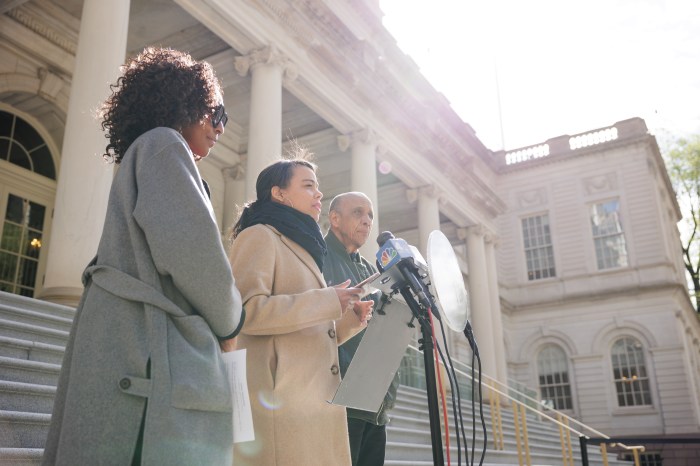US district court in Massachusetts looks to equal protection and the Tenth Amendment
US District Judge Joseph L. Tauro’s pair of rulings on July 8 found that Section 3 of the Defense of Marriage Act (DOMA), enacted in 1996 in reaction to same-sex marriage litigation in Hawaii, violates the Fifth Amendment’s equal protection requirement and rights reserved to the Commonwealth of Massachusetts under the Tenth Amendment. Section 3, the judge found, imposes an unconstitutional condition on state eligibility for funding under certain federal programs, in violation of the Constitution’s Spending Clause in Article I, Section 8.
Tauro, appointed to the federal district court in 1972 by President Richard Nixon, was ruling in cases brought by Gay & Lesbian Advocates & Defenders (GLAD) on behalf of a group of married gay and lesbian couples and widowers in Massachusetts and by State Attorney General Martha Coakley on behalf of the commonwealth, which has been hobbled in its ability to provide full marriage rights to its residents because of the restrictions on federal money imposed by DOMA.
Section 3 of DOMA provides that only a marriage involving one man and one woman will be recognized for any purposes of federal law.
In both cases, plaintiffs sought a judicial ruling that Section 3 was unconstitutional as applied to them in Massachusetts, so the court’s decision has no immediate application outside the state, but could take on greater significance if appealed to and upheld by the US Court of Appeals for the 1st Circuit, which has jurisdiction over the neighboring New England states of New Hampshire (where same-sex couples can marry), Maine, and Rhode Island, as well as Puerto Rico. The Supreme Court might eventually rule on the questions it presents.
In 1993, the Hawaii Supreme Court ruled that the state’s denial of marriage to same-sex couples might violate the state constitution’s Equal Rights Amendment as a form of sex discrimination. In the months leading up to the subsequent trial in Hawaii in the election year of 1996, same-sex marriage suddenly became a national issue. When Georgia Congressman Bob Barr and Oklahoma Senator Don Nickles, both Republicans, introduced DOMA, it was promptly embraced by politicians of both parties, including President Bill Clinton. After winning overwhelming margins in both houses of Congress, Clinton signed it into law less than two months before the election.
Congressional hearings making up the law’s legislative history were concerned primarily with Section 2, which purports to relieve states of any obligation to accord “full faith and credit” to same-sex marriages contracted in other states, with arguments focusing on whether Congress had authority to enact an exception to the Constitution’s Full Faith and Credit Clause. Language from the legislative history, quoted by Judge Tauro, suggests that the discussion revolved largely around sloganeering rather than careful policy-making.
It was not until after the bill’s passage that the General Accounting Office issued a report finding that at least 1,049 federal laws were potentially implicated, a conclusion revised in 2004 to 1,138 statutes. Clearly, DOMA was passed with little regard for its scope or whether the denial of specific rights, benefits, or obligations was justifiable, and subsequent legislation affecting marital status has not been evaluated in light of DOMA.
A report from the House that accompanied the 1996 bill identified four “interests” its enactment advanced –– encouraging responsible procreation and child-bearing; defending and nurturing the institution of traditional heterosexual marriage; defending traditional notions of morality; and preserving scarce resources, in terms of spending and tax considerations.
Tauro noted that the Justice Department does not rely on these four “interests” in defending the statute today, and has actually disavowed them, instead fashioning new arguments based on the recognition that the original four are either invalid or constitutionally unacceptable.
Tauro quickly disposed of the original justifications as well.
After noting studies showing that children raised by gay parents “are just as likely to be well-adjusted as those raised by heterosexual parents,” he reasoned that even if Congress in 1996 believed otherwise, “a desire to encourage heterosexual couples to procreate and rear their own children more responsibly would not provide a rational basis for denying federal recognition to same-sex marriages.”
Instead, denying recognition merely deprives the children of same-sex couples “from enjoying the immeasurable advantages that flow from the assurance of a stable family structure,” quoting from the Massachusetts Supreme Judicial Court’s 2003 same-sex marriage ruling.
Tauro also quoted US Supreme Court Justice Antonin Scalia’s famous comment that “the sterile and the elderly” have never been denied the right to marry, so clearly the ability to procreate is not deemed a prerequisite for marriage.
The idea that DOMA was needed to nurture heterosexual marriage was also rejected, as “this court notes that DOMA cannot possibly encourage Plaintiffs to marry members of the opposite sex because Plaintiffs are already married to members of the same sex… Denying marriage-based benefits to same-sex spouses certainly bears no reasonable relation to any interest the government might have in making heterosexual marriages more secure.”
Defending traditional notions of morality can no longer be offered as a legitimate justification for official discrimination after Lawrence v. Texas, the 2003 sodomy ruling that specifically rejected moral disapproval as justification for denying rights.
Preserving scarce resources is a “legitimate government interest,” Tauro acknowledged, but he could “discern no principled reason to cut government expenditures at the particular expense of Plaintiffs, apart from Congress’ desire to express its disapprobation of same-sex marriage.”
Forced to come up with some new justification instead of the original “interests,” the Obama Justice Department devised the bizarre claim that DOMA was an attempt by Congress to preserve the status quo “pending the resolution of a socially contentious debate taking place in the states over whether to sanction same-sex marriage.” The government argued that DOMA was necessary “to ensure consistency in the distribution of federal marriage-based benefits,” and to avoid the disruptions from having to deal with different definitions of marriage in different states.
Tauro found that history clearly refutes this justification. Marriage requirements have always differed among the states, but the federal government has, until the passage of DOMA, never sought to impose uniformity or refused to provide federal recognition to a marriage lawfully contracted in a state.
He particularly noted the history of interracial marriage, outlawed at various times in more than 40 states, though that number had declined significantly by 1967 when the Supreme Court invalidated miscegenation laws in Loving v. Virginia. During the entire period, the federal government respected mixed-race marriages.
Tauro’s bottom line was that under the US constitutional scheme, marriage and family law have always been the prerogative of the states. Article I, which enumerates the powers of Congress, does not mention marriage, and history shows that proposals to “federalize” marriage law have consistently been rejected by Congress. This includes, of course, Congress’ repeated failure to approve and send to the states for ratification the proposed Federal Marriage Amendment repeatedly introduced by same-sex marriage foes. Even some prominent conservative marriage equality opponents, including Arizona Senator John McCain, refused to support the amendment, based on a states’ rights argument.
In the case brought by GLAD, he found that it was not necessary to determine whether a fundamental right or a suspect classification was involved –– which would have required more exacting judicial scrutiny –– because any federal law that discriminates among similarly situated groups must at a minimum be supported by a rational, non-discriminatory justification, and he found none. Singling out same-sex marriages for across-the-board exclusion from recognition for any purpose under federal law had no reasonable basis, he concluded.
In the case brought by the commonwealth, Tauro found that Congress had clearly overstepped, invading the right reserved to the state under the Tenth Amendment to decide who can marry. He also found that Congress’ power under the Spending Clause could not justify DOMA, because it imposed an unconstitutional condition on Massachusetts, requiring it to discriminate without any rational justification against married same-sex couples in any state program that also involved the use of federal money.
“In the wake of DOMA,” Tauro wrote in GLAD’s case, “it is only sexual orientation that differentiates a married couple entitled to federal marriage-based benefits from one not so entitled. And this court can conceive of no way in which such a difference might be relevant to the provision of the benefits at issue. By premising eligibility for these benefits on marital status in the first instance, the federal government signals to this court that the relevant distinction to be drawn is between married individuals and unmarried individuals. To further divide the class of married individuals into those with spouses of the same sex and those with spouses of the opposite sex is to create a distinction without meaning.
“And where, as here, ‘there is no reason to believe that the disadvantaged class is different, in relevant respects’ from a similarly situated class, this court may conclude that it is only irrational prejudice that motivates the challenged classification. As irrational prejudice plainly never constitutes a legitimate government interest, this court must hold that Section 3 of DOMA as applied to Plaintiffs violates the equal protection principles embodied in the Fifth Amendment.”
In the state’s case, he wrote, “That the government views same-sex marriage as a contentious social issue cannot justify its intrusion on the ‘core of sovereignty retained by the States,’ because ‘the Constitution… divides power among sovereigns and among branches of government precisely so that we may resist the temptation to concentrate power in one location as an expedient solution to the crisis of the day.’
“This court has determined that it is clearly within the authority of the Commonwealth to recognize same-sex marriages among its residents, and to afford those individuals in same-sex marriages any benefits, rights, and privileges to which they are entitled by virtue of their marital status. The federal government, by enacting and enforcing DOMA, plainly encroaches upon the firmly entrenched province of the state, and, in doing so, offends the Tenth Amendment.”
The federal government has 60 days from July 8 to appeal Tauro’s rulings.
There are six active judges on the 1st Circuit Court of Appeals, and three senior judges who continue to sit on some cases. Of the active judges, two were appointed by Clinton, and one each by Presidents Ronald Reagan, George H.W. Bush, George W. Bush, and Barack Obama. Though the active judges are evenly split between Democratic and Republican appointees, all three senior judges were appointed by Republicans –– Richard Nixon, Reagan, and the elder Bush.
The 1st Circuit Court of Appeals does not have an extensive history of rulings on LGBT rights issues.

































